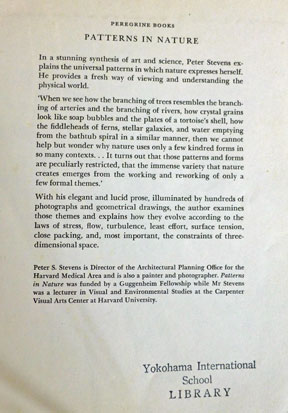PATTERNS IN NATURE by Peter S Stevens 1974: This book I have been looking for ever since I browsed it in Blackwells book shop in Oxford while visiting my brother in 1977. I had no money to buy it then. I found it a couple of years ago, stamped inside: Yokohama International School LIBRARY.
We see the patterns and similarities in tree branches, rivers, tortoise shell, star galaxies. “It turns out that those patterns and forms are peculiarly restricted, that the immense variety that nature creates, emerges from the working and reworking of only a few formal themes.”
This is what I found out: Spirals, meanders, branching patterns, 120 degree joints, occur again and again. Pentagons make most of the flowers. Hexagons handle most of the repetitive 2D patterns but never enclose 3D space. Spiral is versatile. 5 reular polyhedrons can be produced but no more. 7 systems of crystals can be employed but never an eighth. Of all the constraints on nature, the most far reaching are imposed by space. For space itself has a structure that influences the shape of every exisitng thing. (How? what?) We think space is nothingness, an absence BUT nothingness has an architecture that makes demands on things. c.f. the effects of water on fish (buoyancy, pressure, streamlining). Einstein showed there are other kinds of spaces and that patterns and forms in those other spaces differ from the ones we see in ours. How does our kind of space affect the shape of things? Modern physics. This book was written in 1974 so I guess ideas have moved on. But this is all new for me. Space, not a big nothing but a big everything.


